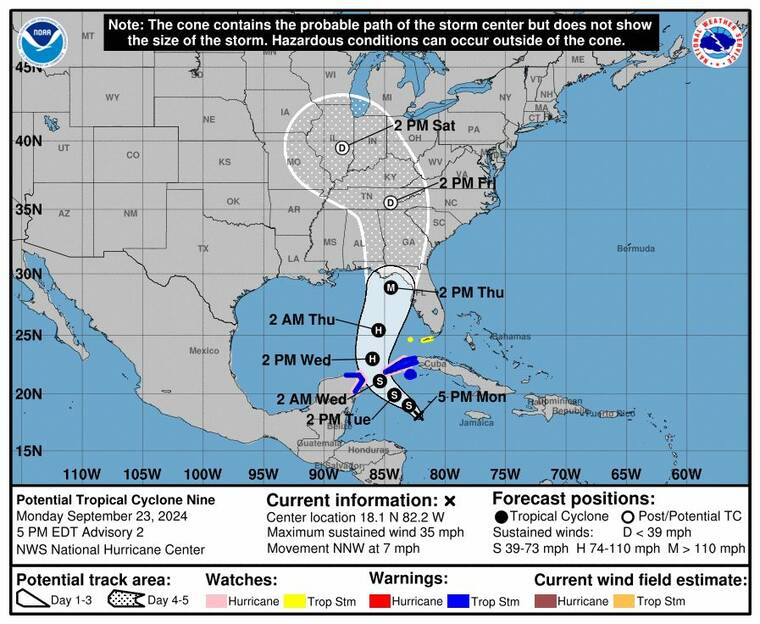
NATIONAL HURRICANE CENTER
Potential Tropical Cyclone Nine is forecast to develop into Hurricane Helene, which is expected to form in the next 48 hours and move toward an area somewhere between Tampa and Pensacola by the end of the week.
Meteorologists warned residents along Florida’s Gulf Coast about the potential for Hurricane Helene, which is expected to form in the next 48 hours and move toward an area somewhere between Tampa and Pensacola by the end of the week.
The National Hurricane Center said in its 5 p.m. update today (11 a.m. Hawaii time) that the system is expected to strengthen into a major hurricane with winds up to 115 mph (185 km/h) before approaching the northeastern Gulf Coast on Thursday.
Due to the risk of storms, Governor Ron DeSantis declared a state of emergency in 41 Florida counties this afternoon.
The storm is developing south of Cuba and is expected to move north into the Gulf of Mexico as it strengthens, according to the National Hurricane Center.
Meteorologists expect the storm to become a hurricane Wednesday morning as it passes between Cuba and the Yucatan Peninsula, before moving northeast toward Florida’s panhandle.
Tropical storm warnings and hurricane warnings are now in place for parts of the Mexican Yucatan Peninsula and Cuba. A tropical storm warning has been issued for the Dry Tortugas and the Lower Florida Keys south of the Seven Mile Bridge.
“Hurricane levels are possible in the observation areas through Wednesday morning. Tropical storm strength is expected in the warning areas beginning Tuesday,” the NHC said.
The system is currently located 105 miles south-southwest of Grand Cayman, moving north-northwest at 7 mph, with maximum sustained winds of 35 mph.
Various computer forecast models – also known as spaghetti models – show that vigilance is needed from Tampa to Pensacola, including Tallahassee.
By Thursday, as the system approaches the Florida Panhandle, wind speeds could reach 110 mph (177 kph), the NHC said, putting the storm at the upper end of a Category 2 hurricane.
High water temperatures favor hurricane formation along the forecast storm path, University of Miami meteorologist Brian McNoldy said on X. “Ocean heat content in the Gulf is *extremely* high, particularly within the Loop Current, over which future Helene will pass,” he wrote.
The NHC’s probability cone currently includes Tampa and extends to the western Panhandle near Pensacola.
“Everyone along the Florida Panhandle and Big Bend region needs to be prepared for the impacts of a hurricane,” said Alex DaSilva, senior hurricane expert at AccuWeather, adding that the constellation has the potential to be the strongest hurricane to make landfall in the U.S. so far this season.
The storm is expected to dump 4 to 8 inches of rain on western Cuba and the Cayman Islands, with isolated totals of about 12 inches. The eastern Yucatan Peninsula can expect 2 to 4 inches of rain, with isolated areas expecting more than 6 inches.
Starting Wednesday, heavy rain will occur in the southeastern United States and will continue through Friday.
Meanwhile, a tropical wave in the far eastern Atlantic could develop into a tropical depression, meteorologists said. The gradual development of this system is possible as it moves westward toward the central Atlantic.
As of 11am today, the probability that the disturbance will develop within the next seven days is 70% higher than on Saturday, when it was only 30%.
Experts at Colorado State University released an updated two-week forecast on Tuesday, predicting normal hurricane activity. According to the forecast, it is very unlikely that there will be above-normal activity in the next two weeks.
The hurricane season lasts from June 1 to November 30, but storms peak from mid-August to October.

